The War Remnants Museum in Saigon is a must-visit destination for anyone wanting to deeply understand Vietnamese history, especially the fierce war period. This place not only preserves valuable artifacts but also authentically and emotionally recreates the pain and loss that the Vietnamese people endured. This article will be a detailed and comprehensive guide to visiting the War Remnants Museum in Saigon, helping you have a complete and meaningful experience.
Introduction to the War Remnants Museum – History and Significance
The War Remnants Museum, located at 28 Vo Van Tan Street, District 3, Ho Chi Minh City, is one of the museums that attracts a large number of domestic and international visitors. Founded on September 4, 1975, the museum was initially named “Exhibition House for US and Puppet Crimes.” In 1990, the museum was officially renamed the War Remnants Museum, a more neutral and humane name, consistent with the message of peace that the museum wants to convey.
The precursor to the museum was Khai Tuong Pagoda under the Nguyen Dynasty. However, this pagoda was destroyed by the French colonialists, and the land was subsequently used for various purposes, from hospitals and law offices to villas. Finally, it became a museum, a place preserving memories of war and the aspiration for peace of the Vietnamese nation.
The War Remnants Museum is not simply a place to display artifacts. The main purpose of the museum is to condemn wars of aggression, especially the crimes committed by foreign forces against Vietnam in the period 1945-1975. At the same time, the museum also honors the indomitable and resilient fighting spirit of the Vietnamese people in the struggle for independence and freedom. Moreover, the museum is also a call for peace and solidarity among nations, towards a future without war and suffering.
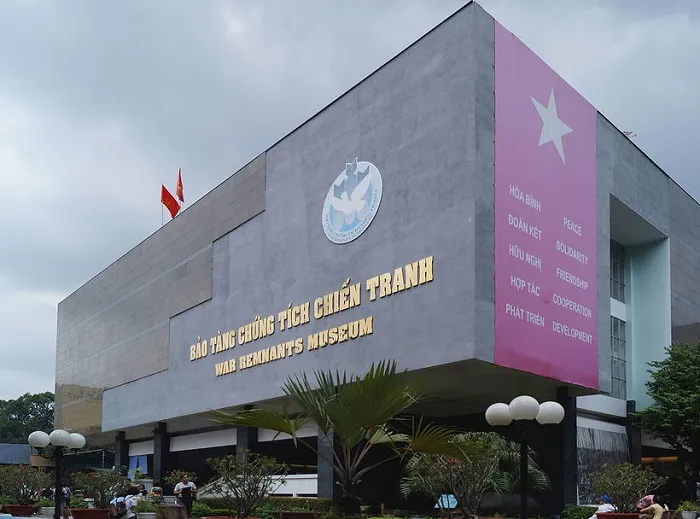
Address and Directions to the War Remnants Museum
The War Remnants Museum is located in the city center, making it very convenient to travel to. The exact address is 28 Vo Van Tan Street, Ward 6, District 3, Ho Chi Minh City. You can easily reach the museum by various means of transport:
Motorbike and private car: This is the most proactive and flexible means of transportation. You can easily find directions to the museum using online map applications like Google Maps or Vietmap. From the city center (District 1), it only takes about 10-15 minutes by motorbike or car. The museum has a spacious parking lot right in front of the gate, but on weekends or holidays, it can be crowded and difficult to find parking.
Taxi and ride-hailing services: Taxis and ride-hailing services (Grab, Be, Gojek…) are suitable options if you don’t want to drive yourself or are unfamiliar with the roads. Just book a car through the app, and you will be taken to the museum gate quickly and conveniently. The cost of traveling by taxi or ride-hailing services from the city center to the museum ranges from 50,000 – 80,000 VND depending on the time and type of vehicle.
Bus: Buses are an economical and popular public transport in Saigon. There are many bus routes that pass by or near the War Remnants Museum, such as routes number 06, 14, 28. You can look up detailed information about bus routes, routes, and stops on the website of the Ho Chi Minh City Public Transport Management Center or the BusMap application. Bus fares are very cheap, only about 6,000 – 7,000 VND/trip.
Walking: If you are near District 3 or want to combine visiting nearby locations, walking is also an interesting option. From the Independence Palace or Notre Dame Cathedral, you can walk to the museum in about 20-30 minutes, while enjoying the Saigon street scene.
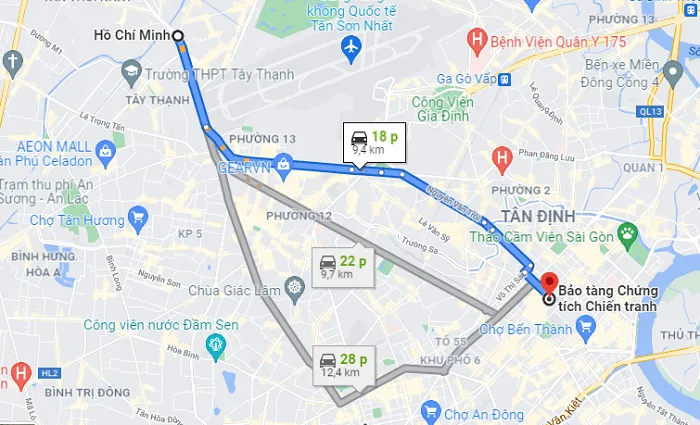
Ticket Prices and Opening Hours of the War Remnants Museum
Entrance fees:
- International visitors: 40,000 VND/person/visit
- Vietnamese visitors: 20,000 VND/person/visit
- Students, seniors: 10,000 VND/person/visit (need to present student ID, senior card or personal identification)
- Free admission:
- Wounded soldiers, sick soldiers, severely disabled people.
- People with meritorious services to the revolution.
- Children under 6 years old.
- Delegations with official letters from the Department of Culture and Sports of Ho Chi Minh City.
Opening hours:
- Every day of the week (including holidays, Tet):
- Morning: 7:30 AM – 12:00 PM
- Afternoon: 1:30 PM – 5:00 PM
Note:
- The ticket counter closes 30 minutes before the museum closing time.
- The best time to visit is early morning or late afternoon to avoid heat and crowds.
- You should spend at least 2-3 hours to visit the museum fully and completely.

Exploring the War Remnants Museum – Main Exhibition Areas
The War Remnants Museum has a fairly large area, including many indoor and outdoor exhibition areas. For an effective guide to visiting the War Remnants Museum in Saigon, you should learn about the layout of the exhibition areas before starting your exploration. Here are some main exhibition areas that you should not miss:
Outdoor Exhibition Area
As soon as you enter the museum grounds, you will be impressed by the outdoor exhibition area, which displays large artifacts, mainly heavy weapons and military equipment used by the US military in the Vietnam War. Here, you can witness firsthand:
- Aircraft: Fighter jets, bombers, helicopters such as AD-6, F-5A, A-37, UH-1H…
- Tanks, armored vehicles: Tanks M48, M41, armored vehicles M113…
- Artillery: 105mm, 155mm cannons, anti-aircraft guns…
- Bombs: Demolition bombs, cluster bombs, napalm bombs…
The outdoor exhibition area not only helps visitors better visualize the scale and ferocity of the war but also provides an opportunity to learn about the types of weapons and military equipment that were used in the war.

Indoor Exhibition Area – Ground Floor
The indoor exhibition area is arranged on two floors. The ground floor is where the main thematic exhibitions are concentrated, reflecting different aspects of the Vietnam War. Some typical thematic exhibitions on the ground floor:
- “World Support for Vietnam’s Resistance”: Displays images, documents, and artifacts showing the support and solidarity of international friends for the just struggle of the Vietnamese people.
- “Aggression War Crimes”: Recreates the crimes committed by the US military and the Saigon government against the Vietnamese people, such as massacres, torture of prisoners, and the use of chemical weapons…
- “Agent Orange Aftermath”: One of the most emotionally moving areas, displaying images and artifacts about the terrible consequences of Agent Orange/dioxin on people and the environment of Vietnam.
- “Historical Truths”: Displays documents, images, and artifacts proving the truth about the Vietnam War, refuting historical distortions.
The exhibitions on the ground floor are usually arranged thematically, with many original artifacts, valuable archival images, along with detailed captions in Vietnamese and English, helping visitors easily access and better understand the exhibition content.
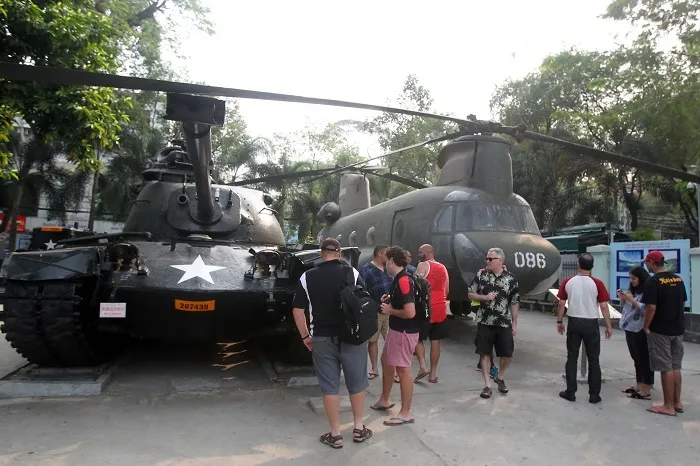
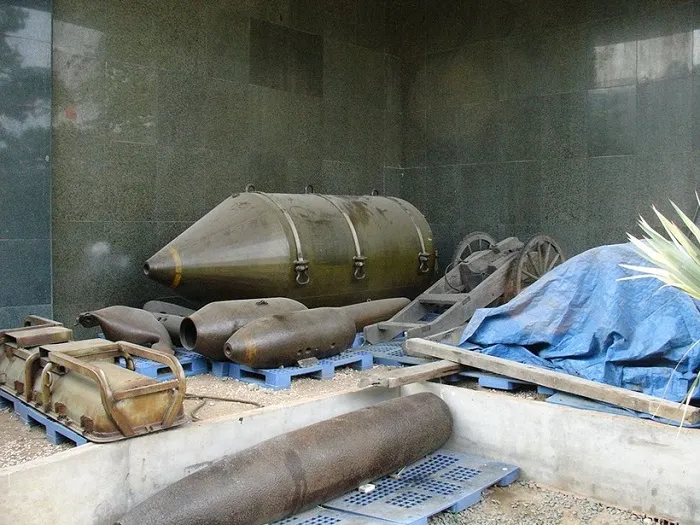
Indoor Exhibition Area – 1st Floor
The 1st floor of the museum continues to bring moving stories and multi-dimensional perspectives on the Vietnam War. Some prominent exhibition areas on the 1st floor:
- “Tiger Cages”: Recreates “tiger cages” – a barbaric form of prison used to detain and torture revolutionary soldiers at Con Dao prison. This area makes a strong impression on visitors due to the brutality and inhumanity of the wartime prison regime.
- “Prison System”: Displays artifacts and images of other prisons during the war, such as Phu Quoc prison, Hoa Lo prison… Through this, visitors can better understand the harsh life and steadfast spirit of the imprisoned revolutionary soldiers.
- “War Souvenirs”: Displays souvenirs of soldiers, journalists, and photographers from inside and outside the country who participated in or reported on the Vietnam War. These souvenirs bear personal imprints and contribute to vividly and truthfully recreating the war.
In addition, the 1st floor also has a documentary screening area, a multi-purpose room, and a souvenir shop, where you can buy meaningful gifts after visiting the museum.

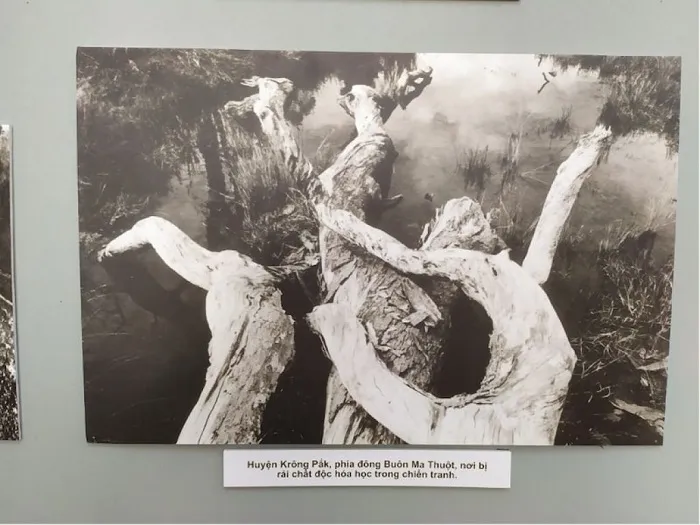

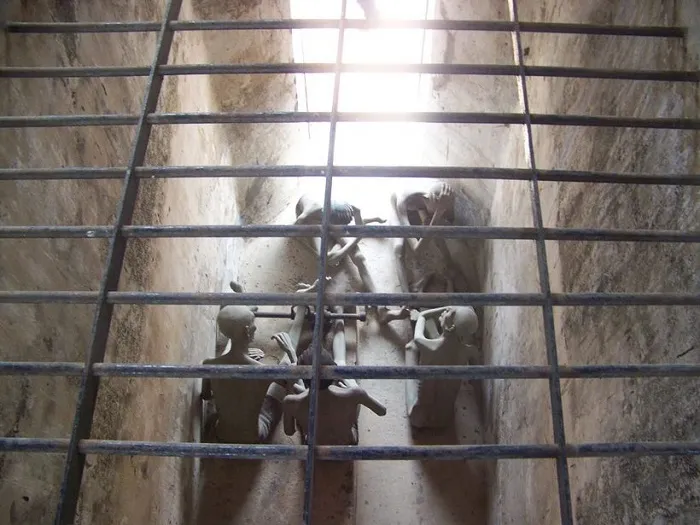
Experiences and Notes when visiting the War Remnants Museum
To have a truly meaningful and complete visit to the War Remnants Museum in Saigon, you should note the following:
- Visiting time: You should spend at least 2-3 hours to have enough time to explore all the exhibition areas. If you want to learn more deeply about each topic, you may need more time.
- Dress code: You should choose polite and discreet clothing when visiting the museum, especially when entering indoor exhibition areas.
- Attitude: Maintain a respectful and serious attitude when visiting the museum. This is a place that preserves the painful memories of the nation, so please show solemnity and empathy.
- Tour guide: If you are traveling in a group or want to learn more deeply about the museum, you can hire a tour guide. The museum has professional tour guide services, with deep understanding of history and exhibited artifacts.
- Do not touch artifacts: Absolutely do not touch the exhibited artifacts without the guidance of museum staff.
- No photography in prohibited areas: Some areas in the museum may prohibit photography to protect artifacts or for sensitive reasons. Please pay attention to the signs and comply with the museum’s regulations.
- Maintain hygiene: Do not litter or eat in the exhibition area. Maintain general hygiene to protect the landscape and environment of the museum.
- Visit on weekdays: If possible, choose to visit the museum on weekdays to avoid crowds, especially on weekends and holidays.
- Combine visiting nearby locations: The War Remnants Museum is located near many other famous tourist attractions in Saigon such as the Independence Palace, Notre Dame Cathedral, City Post Office, Turtle Lake… You can combine visiting the museum with these locations for a rich and diverse travel itinerary.
- Dining near the museum: Around the museum area, there are many eateries and restaurants serving a variety of dishes from affordable to high-end. You can easily find a dining location that suits your taste and budget. Some suggestions: Thuc Coffee, Dong Restaurant, eateries on Vo Van Tan Street, Nguyen Thi Minh Khai…
Conclusion
The War Remnants Museum is not only a historical tourist destination but also a space to reflect on the past, cherish peace, and look towards the future. Hopefully, with the detailed guide to visiting the War Remnants Museum in Saigon above, you will have a truly meaningful and memorable trip. Come and feel, to better understand the heroic history and profound human values that the museum brings.